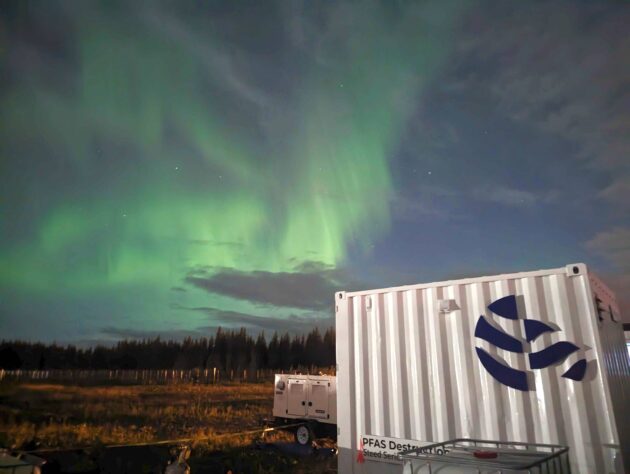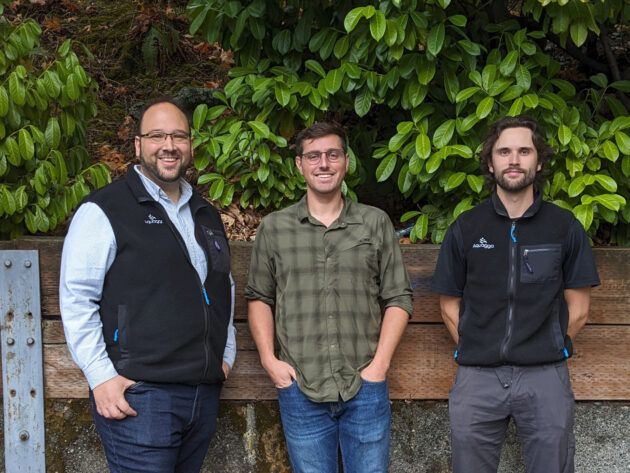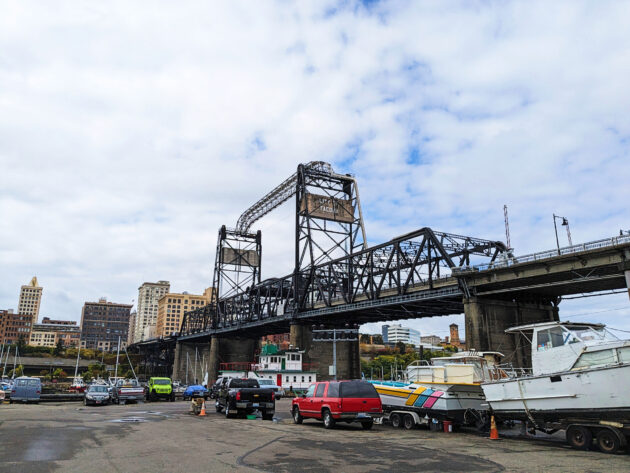
It would be fair to expect the destroyer of toxic “forever chemicals” to be a massive, intimidating device.
In which case it’s either disappointing or delightful to discover that a startup called Aquagga has successfully deployed a PFAS destruction unit nicknamed “Eleanor” that’s housed inside a modest 10-feet-long by 8-feet-wide shipping container.
The system recently returned from an airport in Fairbanks, Alaska, where it put a dent in 20,000 gallons of toxic, PFAS-contaminated wastewater that had accumulated for 40 years.
For decades companies have added PFAS to firefighting foams, food packaging, carpets and fabrics, water-repellent clothing and non-stick pans. The long-lived chemicals are great at deflecting water, stains and grease — but they escape from products and now contaminate drinking water across the nation and are even detected in breast milk. PFAS are still in use, while researchers and regulators are increasingly concerned by their serious health impacts.
“The PFAS problem has been a unique one,” said Nigel Sharp, Aquagga CEO and co-founder. For those working to clean up the pollution, “the tools they’ve had available to them the last 20 to 30 years, nothing works on PFAS.”
Until recently, that is. Now Tacoma, Wash.-based Aquagga and a handful of others are slashing the lifespan of the forever chemicals.

Aquagga has landed $4.7 million in contracts, awards and demonstration projects that include partnerships with seven federal government agencies, and on Wednesday the startup is hosting Washington Gov. Jay Inslee. Aquagga also has $1 million in private funding, including $560,000 raised via the crowdfunding site WeFunder and angel investments from the Alaska Investor Network and E8 Angels. The business is profitable.
And the demand for PFAS cleanup is immense.
“PFAS is incredibly tough to break down and deal with. So we’re very fortunate we’ve validated the technology works.”
– Nigel Sharp, Aquagga co-founder and CEO
PFAS — an acronym for per- and polyfluoroalkyl substances that’s pronounced “p-fas” — include a family of some 9,000 chemicals. By the end of this year, the U.S. Environmental Protection Agency is set to finalize rules expected to limit acceptable PFAS levels in drinking water to infinitesimally small parts per trillion. Attorneys general for 26 states have sued PFAS manufacturers. Early estimates for cleaning up PFAS contaminated drinking water are pegged at more than $400 billion, according to Politico.
Aquagga’s founders say they’re ready to help tackle the challenge.
“PFAS is incredibly tough to break down and deal with,” Sharp said. “So we’re very fortunate we’ve validated the technology works, and we’re now to the point of [going to] commercial scale and growth of the company.”
Weapon of PFAS destruction
Aquagga launched in 2019, won an EPA-sponsored PFAS destruction contest in 2020, and built its first prototype unit two years later.
Today, the company’s R&D operations are housed inside the cavernous Petrich Marine building along Tacoma’s Thea Foss Waterway. Some of its dozen employees also occupy offices in the city’s slow-paced downtown, about a 45-minute drive south of Seattle.
The startup’s weapon of PFAS destruction incorporates technology from the University of Washington and the Colorado School of Mines. It annihilates the pollutants in a device that can reach high pressure and temperature — hitting 570 degrees Fahrenheit. To that they add lye — an ingredient in soap — to create a caustic environment. The conditions dismantle the PFAS, breaking off the compound at its head, chopping up its spine of carbon molecules, and lopping off the fluoride molecules that run along the backbone.

The free fluoride then combines with calcium or sodium to make more benign compounds that are the same as those used for fluoridating water or as a toothpaste ingredient. Any carbon dioxide produced in the process is captured as a solid carbonate.
Testing shows that more than 99% of the PFAS are destroyed in treated water, Sharp said.
And Aquagga’s solution has advantages over other systems, he added, starting with its relatively compact size. The startup’s technology can destroy hard to eradicate short-chain PFAS; it requires a lower temperature and pressure; and it can run continuously rather than in batches, which helps manage the volume of waste and makes automation easier.
Deployment in Fairbanks
PFAS are added to firefighting foams because they help it spread, cooling and suppressing a blaze — but the product is a key source of contamination in freshwater and states including Washington have banned PFAS use in the foams.
The damage, however, persists. At Fairbanks International Airport, a lined, underground pit held 20,000 gallons of water contaminated from PFAS-containing firefighting foam. Left untreated the water would remain hazardous for thousands of years.
Working with a partner, Aquagga this summer pumped out and concentrated the volume of polluted water, reducing it to 1,000 gallons of a foamy toxic substance. The Aquagga team processed about half that amount before weather conditions and technical difficulties halted their progress. Once the Eleanor unit is upgraded and repaired, they’ll finish eliminating the PFAS.

The $2.5 million demonstration project included multiple industrial participants. It was funded by the Federal Aviation Administration and Alaska Department of Transportation with partnership from the airport and the Alaska Department of Environmental Conservation.
“It’s been quite impressive. Seeing it onsite is pretty amazing, said Elise Thomas, environmental program manager at Fairbanks International Airport.
The next big step for Aquagga will be partnering with a manufacturer or other joint venture arrangement to start commercial production. Leaders from the startup are traveling to San Francisco this month to attend SOCAP, the world’s largest gathering of impact investors, and will participate in multiple trade shows.
“It gives us hope, and gives us something to look forward to.”
– Elise Thomas, environmental program manager at Fairbanks International Airport
For now the company’s business focus is targeting contaminated site cleanups, rather than applications such as purifying municipal drinking water.
Sharp isn’t worried about vying against others in the sector. “The scale of the problem is so out of scope with the number of solution systems that are out there,” he said.
That attitude also aligns with the mission of the for-profit, public benefit corporation. The name Aquagga is a play on “quagga,” an extinct relative of the African zebra. The startup’s website explains it’s a “zebra company” seeking to cooperate on PFAS destruction, compared to hard-charging unicorn companies driven by competition.
Thomas expects the Aquagga technology will be attractive to facilities like hers that are struggling with a costly PFAS legacy. There are roughly 20,000 public and private airports in the U.S., plus military airfields.
“It gives us hope,” Thomas said, “and gives us something to look forward to.”
Continue scrolling for other GeekWire photos of Aquagga.







